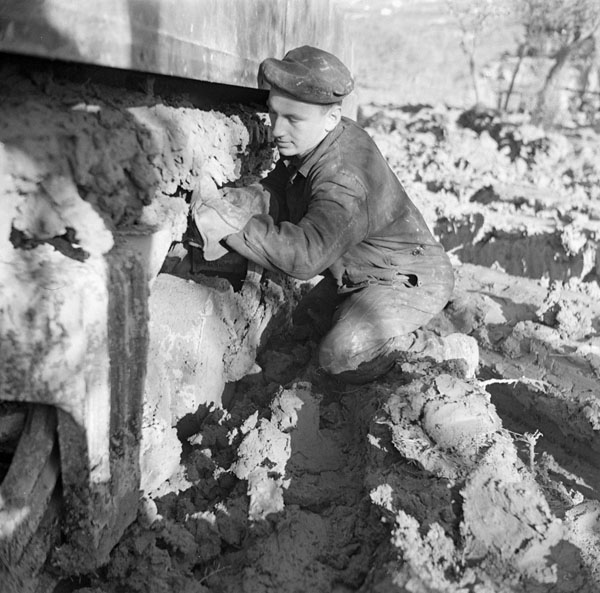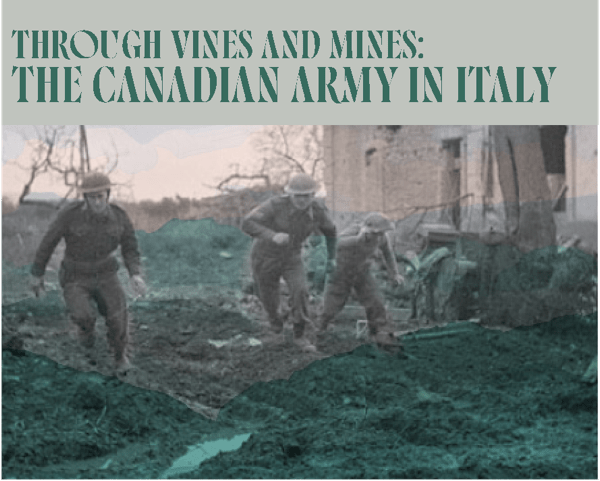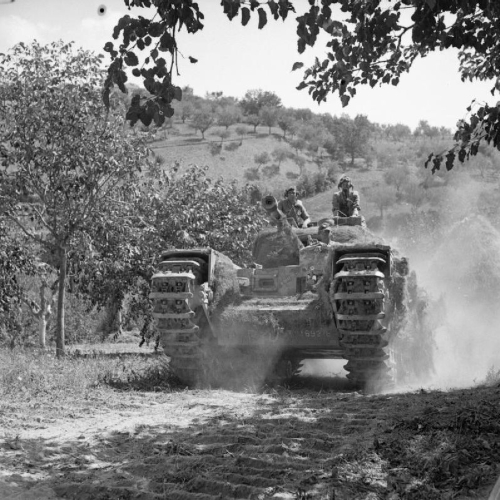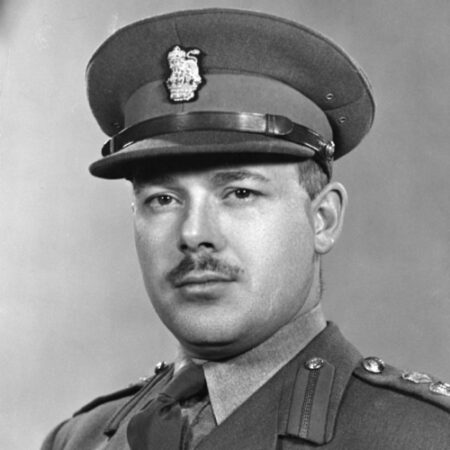The Italian campaign was one of the biggest Canadian campaigns of the Second World War and, for the armoured regiments, it was the first opportunity to put years of training in Britain to the test. This article presents some of the armoured regiments sent to Italy.
The Italian campaign was Canada’s first major operation of the Second World War. With the ultimate goal of overthrowing the Mussolini regime, it was obvious that the Canadian Army would need more heavy tanks than infantry! Prior to the invasion of Sicily, the only operation in which Canadian tank units were involved was during the disastrous Dieppe Raid. At that time, the Calgary Regiment was deployed on the beaches of Dieppe, but was immobilized by the cobbles and could not be as effective as hoped. The Calgary Regiment tried to support the infantry as best they could, but 157 of them (out of 417 deployed) were ultimately captured by the Germans at the end of the fighting. In fact, for all these armoured regiments, this campaign was an opportunity to be truly deployed in combat and to prove themselves.
Find out more about the various armoured units deployed in Italy: the regiments of the 1st Armoured Brigade and the regiments of the 5th Armoured Brigade.
Specificity of Canadian armoured vehicles
During the Italian campaign, Canadian regiments such as the 1st Armoured Brigade drove mainly Sherman tanks assembled in the USA. Other variants of the tank were deployed in Italy. The “Firefly” model, based on a regular Sherman and fitted with a heavier gun, was particularly popular with the British Army in Italy, for example. However, the Canadian regiments deployed in Italy stuck mainly to the regular Sherman, while other tank types were in demand on other fronts.
For the record, Canada also produced two variants of the Sherman tank: the Ram and the Grizzly, both built in Montreal. The former was mainly used for training in Great Britain, and never saw combat. As for the latter, only a small number were built before the project was abandoned in favour of Shermans produced in American factories.
During battles, the role of armoured units is mainly to support infantry, engage tanks and enemy positions and launch charges. However, as historian Keith Donaldson points out, the nature of the terrain in Italy greatly complicated manoeuvrability for tanks. Indeed, between hills, mountains, rivers, vineyards and mud, the Canadian tanks of the two armoured brigades experienced some of the most difficult conditions in which to operate properly.
The 1st Armoured Brigade
Mobilized in Great Britain in 1941, the 1st Armoured Brigade is one of the few independent Canadian armoured brigades. The brigade was at the front from 1943 until 1945, when it was transferred to Western Europe to liberate France, Belgium and the Netherlands. In Italy, the brigade’s regiments built up a strong reputation and became particularly appreciated by the British General Staff, fighting throughout the peninsula.

The Three Rivers Regiment

Members of the Three Rivers Regiment pose with their Sherman tank in Termoli, Italy, October 15, 1943 (source: Library and Archives Canada).
The Calgary Regiment

Indian soldiers of the 5th Mahratta Regiment jump from a Calgary Regiment tank in Florence, Italy, 28 August 1944 (source: Library and Archives Canada).
The Ontario Regiment

A Sherman tank of the Ontario Regiment moves forward at San Pancrazio, 16 July 1944 (source: Library and Archives Canada).
The 5th Armoured Brigade of the 5th Canadian (Armoured) Division
When it was formed, the 5th Canadian (Armoured) Division was created to combine infantry units with armoured units. The division was sent to Italy in November 1943, but it was several months before the armoured regiments were able to take part in the fighting. Many of the vehicles mobilized for the regiments of the 5th Armoured Brigade came from the British Army and were used during the North African campaign. In fact, the Sherman tanks did not arrive until February 1944, while they were being repaired.
British Columbia Dragoons

A tank of the 8th Princess Louise’s is examined by an infantry soldier during the fighting on the Gothic Line, 31 August 1944 (source: Library and Archives Canada).
8th Princess Louise’s (New Brunswick) Hussars

A tank of the 8th Princess Louise’s is examined by an infantry soldier during the fighting on the Gothic Line, 31 August 1944 (source: Library and Archives Canada).
Lord Strathcona’s Horse (Royal Canadians)

Tanks of Lord Strathcona’s Horse carrying out firing exercises in Great Britain, 20 April 1943 (source: Library and Archives Canada).
Conclusion
Tank units were key elements in Canadian operations in Italy. Although they did not have as much experience as their British, American or Indian comrades at the start of the campaign, the members of the tanks shone on all fronts. From their arrival to their departure for Western Europe, Canadian tanks worked hard to accomplish their missions. The Italian campaign gave them the opportunity to build the reputation they still enjoy today.
Article written by Julien Lehoux for Je Me Souviens.
Sources:
- “History of a Regiment“, Lord Strathcona’s Horse (Royal Canadians) Society Website.
- “Main Battle Tanks“, canadiansoldiers.com.
For a more academic approach:
- Jack Wallace, “Shermans in Sicily: The Diary of a Young Soldier, Summer 1943“, Canadian Military History, vol. 7, no. 4, 1998, pp. 63-68.
- Keith L.G. Donaldson, Thunder in the Mountains: 1st Canadian Armoured Brigade in Italy, 1943-1944, University of Calgary, Master’s Thesis (History), 2008, 144 p.
- William McAndrew, “Fifth Canadian Armoured Division: Introduction to Battle“, Canadian Military History, vol. 2, no. 2, 1993, pp. 43-55.
- A. Milroy, “An Introduction to the Battle for the Melfa River“, Canadian Military History, vol. 2, no. 2, 1993, pp. 33-34.
This article was published as part of our exhibition on the Italian Campaign: Through Vines and Mines. Visit our exhibition to learn more about the history of the Canadian who participated in the Italian Campaign!







